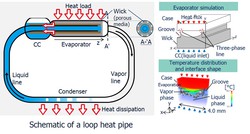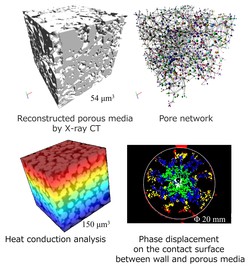
Nishikawara, Masahito
| Affiliation | Department of Mechanical Engineering |
|---|---|
| Title | Assistant professor |
| Fields of Research | Heat transfer, Two-phase flow in porous media, Electrohydrodynamics |
| Degree | Doctor of Engineering (Nagoya University) |
| Academic Societies | Japan Society of Mechanical Engineers / Heat Transfer Society of Japan/Japan Association for Heat Pipe/The Japan Fluid Power System Society/Institute of Electrostatics Japan |
| nishikawara@me Please append ".tut.ac.jp" to the end of the address above. |
|
| Laboratory website URL | http://ec.me.tut.ac.jp/ |
| Researcher information URL(researchmap) | Researcher information |
Research
On aerospace engineering, automotive, electronic equipment such as PC, rapid increase in heat generation density associated with downsizing and efficiency enhancement has become a problem, so the development of high-performance thermal control device is necessary. In particular, capability for energy and space saving is required. Therefore, we are focusing on loop heat pipes (LHPs), which is a two-phase heat transport device using no electric power. To establish the technology, we make basic and applied research with experimental and analytical approach such as the LHP of design and manufacture, performance test under simulated space environment, non-steady-state analysis, performance enhancement by the porous body shape.
Theme1:Study on investigation of two-phase thermal hydraulics in a capillary evaporator of a loop heat pipe for practical application
Overview
A porous structure called as a wick is placed in the evaporator of the LHP in order to generate a capillary force as the driving force. So, physics of vapor-liquid two-phase flow in the porous structure with a phase change is dominant. Since the physical phenomena of the evaporator is not understood well, the design method such as wick shape has not been established. Therefore, we investigate the physical phenomena by three-dimensional analysis and visualization experiment then, to build optimum design theory based on the thermal-hydraulics is out goal.
Selected publications and works
- M. Nishikawara, H. Nagano, and M. Prat, “Numerical Study on Heat Transfer Characteristics of Loop Heat Pipe Evaporator Using Three-Dimensional Pore Network Model,” Applied Thermal Engineering, 2017. http://dx.doi.org/10.1016/j.applthermaleng.2017.02.050
- M. Nishikawara, H. Nagano, “Optimization of wick shape in a loop heat pipe for high heat transfer,” International Journal of Heat and Mass Transfer, Vol. 104, pp. 1083-1089, 2017. http://dx.doi.org/10.1016/j.ijheatmasstransfer.2016.09.027
- 西川原理仁,長野方星,“ポアネットワークモデルを用いたループヒートパイプ蒸発器の気液熱流動挙動の解析(多孔体内気液分布と熱伝達特性)”日本伝熱学会論文集, Vol. 23, No. 4, pp.71-80, 2015. http://doi.org/10.11368/tse.23.71
- M. Nishikawara and H. Nagano, “Parametric Experiments on a Miniature Loop Heat Pipe with PTFE Wicks,” International Journal of Thermal Sciences, Vol. 85, pp. 29-39, 2014. http://dx.doi.org/10.1016/j.ijthermalsci.2014.05.016
- M. Nishikawara, H. Nagano, and T. Kaya, “Transient Thermo-Fluid Modeling of Loop Heat Pipes and Experimental Validation”, Journal of Thermophysics and Heat Transfer, Vol. 27, No. 4, pp. 641-647, 2013. http://dx.doi.org/10.2514/1.T3888
Keywords
Theme2:Liquid-vapor two-phase flow in a porous media
Overview
Immiscible flow in a porous media is utilized in heat pipes, boiling heat-transfer, gas diffusion layers (GDL) in fuel cells and so on, thanks to increasing of interface area and development of capillary force.
The purpose of this study is basic investigation of two-phase thermal hydraulics in capillary structure, specifically mechanism of nucleation at incipience and phase displacement since first bubble generates.
Keywords
Theme3:Development of heat transfer devices using electrohydrodynamics
Overview
Electrohydrodynamics (EHD) pumps using Coulomb's force acting in dielectric liquids (
refrigerant, oils and so on) have advantages of no noise and no vibration because of no mechanical moving parts.
This study investigates electrode configuration for high pump characteristics and develops the pump and the fluid control devices using the EHD phenomenon. Size scale effect on EHD conduction pumps is also investigated for application in small scale devices.
We are also conducting fundamental research on pumps and phase change enhancement applicable to liquid-vapor two-phase flows that utilize dielectrophoretic forces acting at the interface instead of Coulomb forces.
Keywords
Title of class
- Creative Experiment for Mechanical Engineering
- Physics Laboratory
- Research Project




